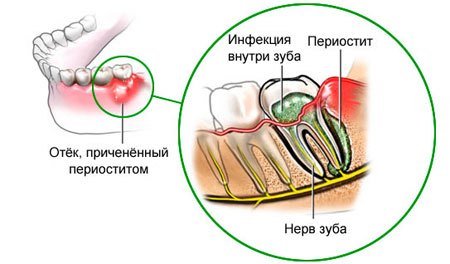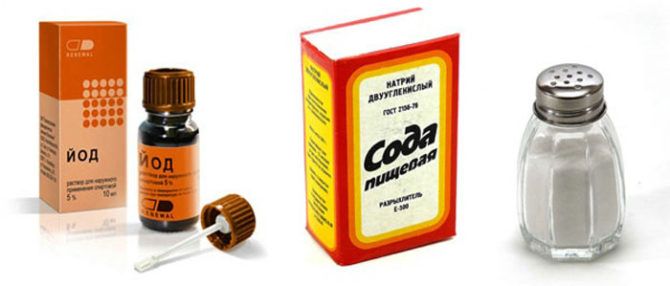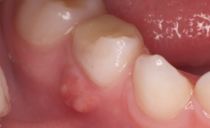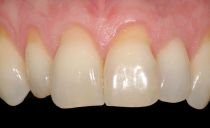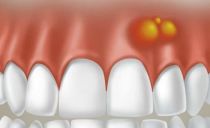Dental flux on the gum and cheek: symptoms, treatment at home
One of the most common diseases in dentistry is gum flux. In scientific, medical language has the name periostitis. Constant aching pain, fever and the threat of complications clearly indicate the need to urgently take action. To do this, you need to know what a tooth flux is. Its causes, symptoms and effective treatments will be discussed below.
Content
- What is tooth flux and what are its symptoms
- No pain flux
- Flux: causes and provoking factors
- Flux Treatment Methods
- How to treat flux at home
- Recipe 1 - Rinse Sage
- Recipe 2 - Rinse Calamus Root
- Recipe 3 - Rinse with a collection of herbs: St. John's wort, sage, oak bark
- Recipe 4 - Rinse Soda
- Recipe 5 - Rinse with iodine and soda-saline
- Recipe 6 - Lot of Soda
- Recipe 7 - Herb Compress
- Recipe 8 - A lotion of salt, sugar and pepper
- Recipe 9 - Clay Compress
- Recipe 10 - Compress with Dimexidum
- What will happen if flux is not treated
- How to treat flux
- Flux Prevention
What is tooth flux and what are its symptoms
Flux is an inflammatory process in the periosteum in the jaw, accompanied by the formation of an abscess with a localized accumulation of pus. More often, an adult suffers from an ailment, since problems with the condition of the teeth may appear with age. But sometimes flux can occur in children. Regardless of age, the clinical picture will be the same for everyone.
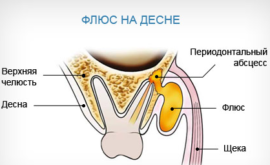 Flux is accompanied by swelling on the cheek. The area next to the focus of infection may swell. Depending on the localization, the nasolabial fold, eye, chin can also inflate. A strong throbbing pain radiating to the temples, eyes - the second indispensable companion of acute inflammation. These are the most common symptoms of incipient periostitis. Other common symptoms that accompany the disease:
Flux is accompanied by swelling on the cheek. The area next to the focus of infection may swell. Depending on the localization, the nasolabial fold, eye, chin can also inflate. A strong throbbing pain radiating to the temples, eyes - the second indispensable companion of acute inflammation. These are the most common symptoms of incipient periostitis. Other common symptoms that accompany the disease:
- malaise, weakness;
- temperature increase up to 38 degrees;
- headache;
- swelling of the affected and surrounding areas;
- redness of the oral mucosa;
- enlarged lymph nodes in the area of inflammation.
Another early symptom that accompanies dental flux is pressure pain. When chewing, it will hurt exactly the area in the region of which then a swollen, sealed ball with pus can come out. In the photo and video on the Internet you can see what a tooth flux is and its visible, obvious signs that you can not confuse with other diseases of the oral cavity.
No pain flux
Flux can flow without pain. Symptoms are so mild that the patient does not even give any discomfort of great importance. A person can look absolutely healthy and feel relatively good. The reason for this course of the disease is the transition to an internal, chronic form. In this case, the process proceeds slowly and for a long time (4-8 months). With this form of flux, a tumor does not form on the cheek. Against the background of a sluggish inflammation, constant relapses can be observed. The weaker the immune system, the more they occur.
The main reason for the transition to a latent form is the lack of high-quality treatment of the flux in the acute stage or an untreated, not yet eliminated infection that will regularly appear again.
Flux: causes and provoking factors
The cause of the disease is always bacteria that began to proliferate amid weak immunity. The development of infection may be the result of:
- advanced carious processes in the teeth;
- mechanical damage to the gums, jaw;
- sore throats, chronic tonsillitis and other infectious and inflammatory processes of the pharynx and oral cavity, which were left without treatment;
- gingival inflammation;
- infection by medical intervention in case of inadequate handling of instruments;
- untimely removed old fillings.
In the cold season, when the body’s immunity is significantly reduced, the risk that the flux develops on the gum or the chronic form worsens significantly increases. Hypothermia, viruses, stress and neurosis, bad habits (smoking, alcoholism) are factors that contribute to the growth of bacteria.
Flux Treatment Methods
To know how to get rid of flux, it is necessary to determine the main factors of effective treatment. In order for it to be of high quality, adequate and timely, it is necessary to consult a dentist at the first sign. Only a specialist will correctly resolve the issue of how to cure flux quickly and without complications.
The duration of flux treatment and its outcome depend on the stage of the pathological process, its form, nature. Before writing a prescription and giving recommendations for treatment, the doctor interviews the patient. Based on the examination, complaints, results of bacteriological research, a decision is made how and how to treat flux.
At an early stage, when the purulent head of the boil is not yet ripe, the specialist prescribes antibacterial treatment in combination with absorbable, anti-inflammatory drugs. For unbearable, severe pain, pain medication is prescribed. Antipyretic medicines are recommended if the temperature rises above 38 degrees. At temperatures below this threshold, the body can and must fight the infection on its own. Throughout the treatment, it is necessary to visit the doctor’s office several times to monitor the treatment process and make sure that the prescribed medication will help with flux and will be effective against this pathogen.
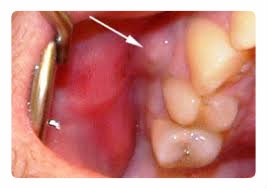 As the disease develops, a purulent sac forms, which will be removed after full maturation. With the use of an anesthetic, the doctor cuts the skin in the affected part, which allows you to open the abscess and help the purulent contents go out. The oral cavity is treated with antiseptic solutions. In order to completely remove pus, drainage is done. A rubber plate is installed into the incision, which contributes to a full outflow of purulent fluid. It cannot be pulled out independently. She may fall out herself ahead of schedule, in which case she will need to come to the hospital again to establish her. To open an abscess is necessary only in a dental office by a specialist. Otherwise, there is a risk of blood poisoning.
As the disease develops, a purulent sac forms, which will be removed after full maturation. With the use of an anesthetic, the doctor cuts the skin in the affected part, which allows you to open the abscess and help the purulent contents go out. The oral cavity is treated with antiseptic solutions. In order to completely remove pus, drainage is done. A rubber plate is installed into the incision, which contributes to a full outflow of purulent fluid. It cannot be pulled out independently. She may fall out herself ahead of schedule, in which case she will need to come to the hospital again to establish her. To open an abscess is necessary only in a dental office by a specialist. Otherwise, there is a risk of blood poisoning.
Depending on the severity of the inflammation, its neglect, the dentist can remove the tooth. This exceptional measure is necessary if it is deeply damaged, and you need to stop the penetration of the infection even deeper into the tissue.
After opening the overripe abscess as prescribed by the doctor, antibiotic and anti-inflammatory flux therapy may continue for some time. Ointments and gels of local action help relieve swelling, remove the remains of purulent exudate, relieve pain, and accelerate healing:
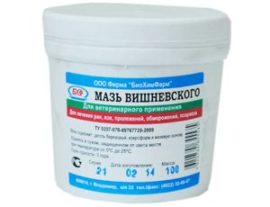 Vishnevsky ointment (may also be called as ichthyol). It can be used only at the initial stage before the formation of an abscess, so that the boil can quickly mature, swell and then open surgically. After resection, the ointment helps the remnants of pus to come out, stretches it. A small amount is applied to the bandage and applied to the affected area for several hours.
Vishnevsky ointment (may also be called as ichthyol). It can be used only at the initial stage before the formation of an abscess, so that the boil can quickly mature, swell and then open surgically. After resection, the ointment helps the remnants of pus to come out, stretches it. A small amount is applied to the bandage and applied to the affected area for several hours.- Levomekol. The active substance of the ointment unfolds the fight against bacteria. To use it, the abscess must already be opened. From cotton wool or bandage you need to make flagella and lay in the wound. The medicine is kept up to 2-3 hours.
- Metrogil Denta. The gel is rubbed into the gum.It has not only an antimicrobial effect, but also helps to remove pain, relieve redness.
Physiotherapy is prescribed to speed healing. This is the final stage of treatment, but no less important in order to prevent re-infection and the transition to a chronic form.
To accelerate the healing process in complex therapy, flux treatment at home can be prescribed.
How to treat flux at home
Many people wonder what to do when the flux begins, if a visit to the dentist is scheduled only after a few days. In this case, the means of traditional medicine help out. But they in no case are an independent type of flux treatment at home. They are effective in addition to antibacterial drugs, alleviating symptoms and helping to rinse suppuration, eliminate pain, redness, poor health, fever. Among the effective and most frequently prescribed procedures that help with flux are:
- rinse (soda, herbal preparations);
- lotions;
- anti-inflammatory compresses.
The following recipes will explain in detail how to treat flux at home using ordinary soda, salt, iodine, herbs and healing clay.
Recipe 1 - Rinse Sage
In a glass, brew 60 g. sage (or 2 tbsp.spoons) boiling water. For an hour you need to let it brew. It is necessary to rinse with warm infusion every hour (with severe inflammation) or every two to three hours (with a subsiding process).
Recipe 2 - Rinse Calamus Root
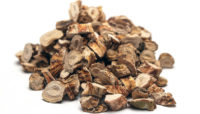 Shredded, dried calamus root in an amount of 20 g. Pour boiling water (half a liter). Half an hour is enough to make the infusion ready for use. It is better to rinse your mouth after each meal and at bedtime.
Shredded, dried calamus root in an amount of 20 g. Pour boiling water (half a liter). Half an hour is enough to make the infusion ready for use. It is better to rinse your mouth after each meal and at bedtime.
Recipe 3 - Rinse with a collection of herbs: St. John's wort, sage, oak bark
It is necessary to mix in the following proportions: 4 tbsp. l St. John's wort, 3 tbsp. l sage and 2 tbsp. l oak bark. Pour boiling water over the collection and let stand for about an hour. The more often there is an opportunity to rinse, the better.
Recipe 4 - Rinse Soda
Ordinary, baking soda is diluted in boiled water at room temperature. On a glass of water put one teaspoon. Rinse with soda every two hours.
Recipe 5 - Rinse with iodine and soda-saline
Half a teaspoon of soda and salt should be mixed. Add three drops of iodine and dissolve in a glass of warm water. Rinse every hour.
Recipe 6 - Lot of Soda
1 gauze is wrapped in gauze l baking soda. Lightly moisten with water and apply to a diseased tooth.
Recipe 7 - Herb Compress
In equal proportions (1 tbsp. L.), Mix periwinkle grass, mint, angelica and birch buds. The mixture is poured with alcohol (you can take vodka) in an amount of 700 ml. This tincture should be prepared in advance, because it needs to stand for about 2 weeks for complete readiness. The resulting liquid is wetted with a cotton pad or folded piece of bandage and applied to the flux area. You can apply the compress up to three times a day.
Recipe 8 - A lotion of salt, sugar and pepper
Mix in a tablespoon in equal proportions salt, sugar and black, ground pepper. Three percent vinegar is added to the mixture and a spoon is heated (above a candle or stove) until a thick mass is formed. The resulting substance is applied to the affected area of the flux in the mouth.
Recipe 9 - Clay Compress
Soak yellow or blue clay (sold in pharmacies) in lemon juice with the addition of water. Pour in water gradually until a creamy consistency of medium density is obtained. It is necessary to thoroughly mix the mass and attach to the tumor on the gum. Wash off after 15 minutes.
Recipe 10 - Compress with Dimexidum
An excellent antimicrobial agent for flux is a solution of dimexide. To 20 ml of the drug add 80 ml of liquid. It moistens gauze, folded in several layers, and is applied twice a day to the inflammatory focus.
What will happen if flux is not treated
If it is improperly treated or the inflammatory process is left without proper attention, the consequences can be serious, even fatal. If you take measures on time already at the first symptoms of flux, you can avoid:
- Purulent Stages. This is a localized area surrounded by a protective membrane in order to prevent the spread of infection to nearby tissues;
- Chronic course of the disease. An abscess can ripen, burst and burst out on its own, without surgical intervention. In this case, relief comes, swelling and pain go away. It may seem that the process has stopped. But this is not so. Inside the tissues where the boil has jumped out, there may still remain exudate residues that will accumulate again and again, and in the future, inflammation can again begin and the abscess jump up.
- Phlegmon (which is also called diffuse purulent inflammation without clear boundaries). Prompt assistance in previous cases may allow the patient not to be afraid for his life. The most dangerous complication is inflammation, when the infection is no longer localized in one area, but affects the soft tissues, can move through the lymphatic flow to the heart, lungs, and brain. The consequences may be irreversible. Dying due to an untreated disease is stupid. That is why it is so important that, when primary symptoms appear, they should be treated right away, and not start the process by delaying the appeal to a medical institution.
How to treat flux
Without the advice of a doctor, you can never do treatment at home. In the event of a flux at home, in no case should:
- Try to break through the abscess with a needle.
An abscess should only be opened surgically in a hospital with antiseptic treatment.
- Make warming compresses on the sore spot, go to the bathhouse or warm the inflamed place in other ways. The rate of infection multiplication will become even faster, the gums will swell and swell even more, which will lead to the exit of pus beyond, i.e., to phlegmon.
- Bandaging a swollen cheek.
- Prescribe medications and treatment for yourself. Antibiotics are selected solely on the basis of the sensitivity of bacteria to a specific active substance. For this, a smear is taken for bacteriological examination. Otherwise, you only start the process, losing time at the initial stage, and get unpleasant consequences in the work of the kidneys, liver, stomach. The same applies to anti-inflammatory drugs. Their dose is selected individually, otherwise the treatment will not be effective.
- Take aspirin after resection. An open wound should heal, heal. Acetylsalicylic acid can cause bleeding.
Flux Prevention
Prevention is not an empty instruction, but the most effective way to avoid not only flux on the gums, but also other consequences for your health. In order to prevent an acute form of the disease or relapse, it is enough to know and follow the following rules.
- In time to treat tooth decay and other diseases of teeth and gums.
- Visit the dentist 2 times a year for the purpose of preventive examinations.
- Carry out professional cleaning of teeth from plaque and tartar at least 1 time per year.
 Thorough oral hygiene in the morning and evening: clean only with an individual brush for at least two minutes. The toothbrush should be changed once a month and after an infectious or viral disease.
Thorough oral hygiene in the morning and evening: clean only with an individual brush for at least two minutes. The toothbrush should be changed once a month and after an infectious or viral disease.- Since the interdental spaces are quite narrow, in addition to the brush, it is necessary to use toothbrushes, flosses, etc.
- After each meal, it is advisable to rinse your mouth or brush your teeth (in case the rinse does not remove the remnants of food).
- Follow personal hygiene rules: wash your hands often, use an individual towel, etc. In this case, the risk of bacteria and infection is minimal.
- Strengthen general immunity.A small amount of pathogenic flora is always present in the human body. In the presence of a provoking factor (stress, acute respiratory infections, acute respiratory viral infections, etc.), bacteria begin to multiply actively, which leads to unpleasant consequences.
- Reduce the number of exacerbations of chronic diseases of the oral cavity and pharynx (tonsillitis, tonsillitis, pharyngitis) and do not start their treatment.
- Get rid of bad habits.
Acute pain after surgical dissection of the abscess can take up to 12 hours. Perhaps the preservation of minor pain up to three days. This is a normal phenomenon, since after purulent inflammation it is impossible to quickly get rid of its traces. The treatment methods listed in the article and recommendations on how to cure the flux cannot be ignored. It is mandatory to take antibiotics, anti-inflammatory drugs and the use of folk remedies, which help from flux and facilitate its course.
After the treatment, you must definitely listen to your body and monitor your well-being. If any unpleasant sensations in the jaw area occur, teeth should not be waited for the cheek to swell, but urgently go to a medical institution where professionals will deal with flux treatment. If all ailments are treated at the initial stage, then complications will not arise, tooth extraction will be avoided, and a return to normal life will be quick.


